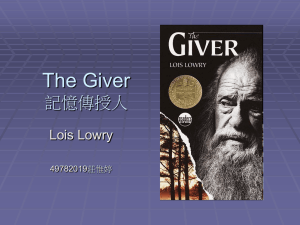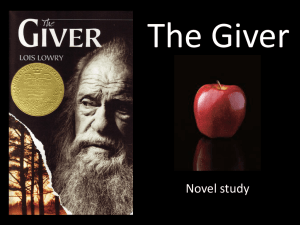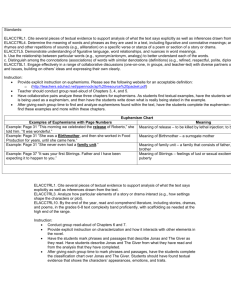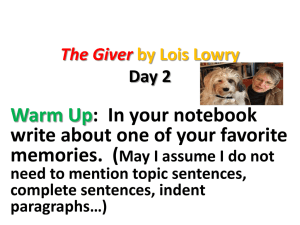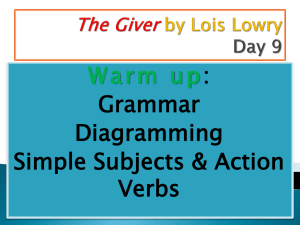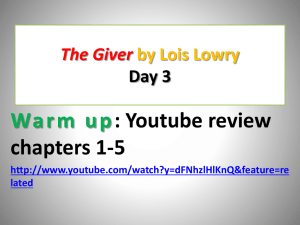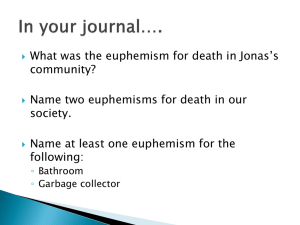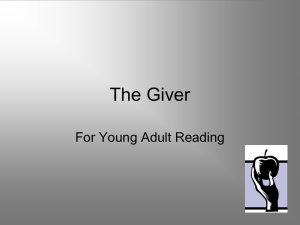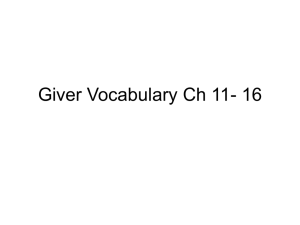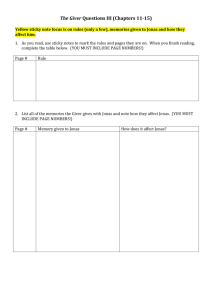Grade 8 Unit One Sample
advertisement
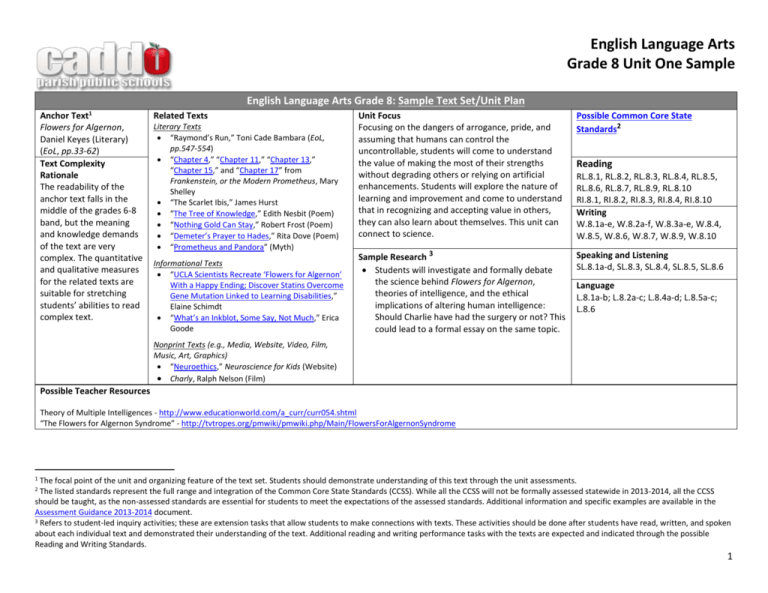
English Language Arts Grade 8 Unit One Sample English Language Arts Grade 8: Sample Text Set/Unit Plan 1 Anchor Text Flowers for Algernon, Daniel Keyes (Literary) (EoL, pp.33-62) Text Complexity Rationale The readability of the anchor text falls in the middle of the grades 6-8 band, but the meaning and knowledge demands of the text are very complex. The quantitative and qualitative measures for the related texts are suitable for stretching students’ abilities to read complex text. Related Texts Literary Texts “Raymond’s Run,” Toni Cade Bambara (EoL, pp.547-554) “Chapter 4,” “Chapter 11,” “Chapter 13,” “Chapter 15,” and “Chapter 17” from Frankenstein, or the Modern Prometheus, Mary Shelley “The Scarlet Ibis,” James Hurst “The Tree of Knowledge,” Edith Nesbit (Poem) “Nothing Gold Can Stay,” Robert Frost (Poem) “Demeter’s Prayer to Hades,” Rita Dove (Poem) “Prometheus and Pandora” (Myth) Informational Texts “UCLA Scientists Recreate ‘Flowers for Algernon’ With a Happy Ending; Discover Statins Overcome Gene Mutation Linked to Learning Disabilities,” Elaine Schimdt “What’s an Inkblot, Some Say, Not Much,” Erica Goode Unit Focus Focusing on the dangers of arrogance, pride, and assuming that humans can control the uncontrollable, students will come to understand the value of making the most of their strengths without degrading others or relying on artificial enhancements. Students will explore the nature of learning and improvement and come to understand that in recognizing and accepting value in others, they can also learn about themselves. This unit can connect to science. Possible Common Core State Standards2 Sample Research 3 Students will investigate and formally debate the science behind Flowers for Algernon, theories of intelligence, and the ethical implications of altering human intelligence: Should Charlie have had the surgery or not? This could lead to a formal essay on the same topic. Speaking and Listening SL.8.1a-d, SL.8.3, SL.8.4, SL.8.5, SL.8.6 Reading RL.8.1, RL.8.2, RL.8.3, RL.8.4, RL.8.5, RL.8.6, RL.8.7, RL.8.9, RL.8.10 RI.8.1, RI.8.2, RI.8.3, RI.8.4, RI.8.10 Writing W.8.1a-e, W.8.2a-f, W.8.3a-e, W.8.4, W.8.5, W.8.6, W.8.7, W.8.9, W.8.10 Language L.8.1a-b; L.8.2a-c; L.8.4a-d; L.8.5a-c; L.8.6 Nonprint Texts (e.g., Media, Website, Video, Film, Music, Art, Graphics) “Neuroethics,” Neuroscience for Kids (Website) Charly, Ralph Nelson (Film) Possible Teacher Resources Theory of Multiple Intelligences - http://www.educationworld.com/a_curr/curr054.shtml “The Flowers for Algernon Syndrome” - http://tvtropes.org/pmwiki/pmwiki.php/Main/FlowersForAlgernonSyndrome 1 The focal point of the unit and organizing feature of the text set. Students should demonstrate understanding of this text through the unit assessments. The listed standards represent the full range and integration of the Common Core State Standards (CCSS). While all the CCSS will not be formally assessed statewide in 2013-2014, all the CCSS should be taught, as the non-assessed standards are essential for students to meet the expectations of the assessed standards. Additional information and specific examples are available in the Assessment Guidance 2013-2014 document. 3 Refers to student-led inquiry activities; these are extension tasks that allow students to make connections with texts. These activities should be done after students have read, written, and spoken about each individual text and demonstrated their understanding of the text. Additional reading and writing performance tasks with the texts are expected and indicated through the possible Reading and Writing Standards. 2 1 English Language Arts Grade 8 Unit One Sample OVERVIEW What will students know and be able to do by the end of this unit? Students will demonstrate an understanding of the unit focus and meet the expectations of the Common Core State Standards on the unit assessments. Unit Focus The “big ideas” of this unit include: Unit Assessment Daily Performance Tasks Students will demonstrate understanding of the “big ideas” through various assessments: Daily instruction and tasks aligned to the CCSS prepare students to meet the expectations of the unit assessments. 1. A culminating writing task, which assesses whether students met the expectations of the CCSS while demonstrating understanding of the anchor text. 2. A cold-read assessment, which assesses whether students can read “new” text(s) and apply the same level of understanding and mastery of the CCSS. 3. An extension task and accompanying presentation, which assesses student ability to apply understanding of the “big ideas” to other texts, their lives, and/or the real world. Students will demonstrate their daily: 1. Understanding of texts and the “big ideas” by meeting grade level CCSS expectations for reading, listening, and language; 2. Ability to express their understanding by meeting grade level CCSS expectations for speaking, writing, and language. 2 English Language Arts Grade 8 Unit One Sample ASSESSMENTS TYPE Culminating Writing Task CONTENT Student Prompt: Analyze how Jonas’ point of view is developed and contrasted with the points of view of other characters in The Giver. How does his point of view, along with the resulting conflict, affect the reader’s understanding of the text and develop a theme? Write an essay that demonstrates command of proper grammar, usage, punctuation, and spelling, and uses grade-appropriate words and phrases. Cite several pieces of textual evidence to support the analysis. CCSS ALIGNMENT RL.7.1, RL.7.2, RL.7.3, RL.7.6, W.7.1a-e, W.7.4, W.7.5, W.7.9a, W.7.10, L.7.2a-b, L.7.3a, L.7.6 Teacher Note: Students are asked to explain Jonas’ point of view (Unit Focus #1) explain other characters’ points of view (Unit Focus #1) explain how these differences create a conflict (Unit Focus #2) determine a resulting theme and explain how it is developed (Unit Focus #1, #3, and #4) Return to Unit Overview Return to Sample Pacing Chart TYPE CONTENT Student Prompt: Read “The Road Not Taken,” and the “Newberry Acceptance Speech, June 1994.” Then answer a combination of multiple-choice and constructed-response questions4. Sample questions: 1. What are the speaker’s beliefs about choice in “The Road Not Taken” and how are his beliefs developed? Provide at least two details from the poem to support your response. 2. Compare the speaker’s beliefs about choice in “The Road Not Taken” to Jonas’ beliefs about choice in The Giver. Provide at least one detail from both texts to support your response. Cold-Read 3. Select one of the memories Lois Lowry shares in her acceptance speech. Summarize how the memory is Assessment portrayed in The Giver. Then explain how Lois Lowry uses and alters her memories to create a part of The Giver. Provide details from both texts to support your response. Teacher Note: Students are asked to explain how the concept of choice is explored in various texts (Unit Focus #2) determine how story develops from memory (Unit Focus #1) Return to Unit Overview 4 CCSS ALIGNMENT (Note: Standards alignment depends on question content) RL.7.1, RL.7.2, RL.7.3, RL.7.4, RL.7.6, RL.7.9, RL.7.10; RI.7.1, RI.7.2, RI.7.3, RI.7.4, RI.7.10; W.7.4, W.7.9a-b, W.7.10; L.7.1a, L.7.3a, L.7.4a, L.7.5a-b, L.7.6 Ensure that students have access to the complete texts as they are testing. 3 English Language Arts Grade 8 Unit One Sample ASSESSMENTS Return to Sample Pacing Chart TYPE CONTENT CCSS ALIGNMENT Student Prompt: In The Giver and your independent reading novel, you examined the measures taken to create utopian societies. In collaborative groups: Identify how each society achieves or falls short of achieving perfection based on the principles they’ve established and determine a resulting theme that is central to both texts Analyze and compare how the theme is developed over the course of each text (i.e., How do the RL.7.1, RL.7.2, RL.7.3; W.7.4, words, actions, interactions, and conflicts of the characters provide a comment on life that is similar W.7.6, W.7.9a, W.7.10; SL.7.1aor different in the two texts?) d, SL.7.4, SL.7.5, SL.7.6; L.7.2a-b, Record the analysis of the group (e.g., via notes, journal, graphic organizer) and include several pieces Extension L.7.3a, L.7.6 of cited textual evidence Task and Create a multimedia presentation that presents the group’s claims and findings in a focused and Formal coherent manner that includes pertinent descriptions, facts, details, and examples. Incorporate visual Presentation displays to clarify claims and findings and emphasize salient points Present the information to the class using appropriate speech that demonstrates command of formal English Teacher Note: Students are asked to identify how the society in each novel attempts to achieve perfection (Unit Focus #1, #2, and #3) evaluate the results of each society’s attempt to achieve perfection (Unit Focus #3) determine a resulting theme common to both texts and explain how it is developed (Unit Focus #1, #2, #3, and #4) create a multimedia presentation to present claims and gathered information Return to Unit Overview Return to Sample Pacing Chart 4 English Language Arts Grade 8 Unit One Sample PACING OF TEXTS AND TASKS INSTRUCTIONAL DAYS TEXT(S)5 Days 1-2 “Preamble,” Constitution of the United States and Chapter 1 of The Giver (Focus6: First section of Chapter 1) Days 3-5 Chapters 2-8 of The Giver (Focus: Last page of Chapter 3) Days 6-10 Days 11-12 Days 13-16 Days 17-19 Days 20-21 Days 22-23 Days 24-28 Excerpt from The Hunger Games, Suzanne Collins and corresponding film clip from The Hunger Games, Gary Ross and Chapters 9-11 of The Giver (Focus: Second half of Chapters 9 and 11) Chapter 12 of The Giver and possible texts on color science (as needed); begin independent reading of dystopian novel with independent and collaborative activities “Preamble,” Constitution of the United States “The Human Abstract,” William Blake and “Imagine,” John Lennon and Chapters 13-16 of The Giver (Focus: First part of Chapter 13, Chapter 13 from “‘Do you advise them often?’ Jonas was a little frightened at the thought…” until the end of that section, and the second section of Chapter 16); continue independent reading of dystopian novel Chapters 17-19 of The Giver (Focus: Last pages of Chapter 18 and all of Chapter 19); continue independent reading of dystopian novel Chapters 20-23 of The Giver (Focus: Last pages of the novel); continue independent reading of dystopian novel “Harrison Bergeron,” Kurt Vonnegut, Jr. and 2081, Chandler Tuttle; continue independent reading of dystopian novel Days 29-31 Culminating Writing Task from Unit One Assessments; continue independent reading of dystopian novel Days 32-34 The Truman Show, Peter Weir (Film); finish independent reading of dystopian novel Days 35-39 Extension Task from Unit One Assessments, group collaboration and presentation preparation CCSS ALIGNMENT Sample Daily Performance Tasks Sample Daily Performance Tasks Sample Daily Performance Tasks Sample Daily Performance Tasks Sample Daily Performance Tasks Sample Daily Performance Tasks Sample Daily Performance Tasks Sample Daily Performance Tasks Sample Daily Performance Tasks Unit One Assessments Sample Daily Performance Tasks Unit One Assessments 5 Texts can be written or visual, print or multimedia. The focus passages contain opportunities for rich instruction of the CCSS and allow students the opportunities to meet the expectations of the CCSS; they can be examined closely and read multiple times. For additional information about pacing and the different instructional purposes for texts, refer to the Guide for Pacing Texts. 6 5 English Language Arts Grade 8 Unit One Sample PACING OF TEXTS AND TASKS Days 40-42 Formal Presentations from Unit One Assessments Unit One Assessments Days 43-45 Cold-Read Assessment from Unit One Assessments Unit One Assessments 6 Appendix A1 English Language Arts Grade 8 Unit One Sample DAILY PERFORMANCE TASKS/PROMPTS DAYS 1-2 Text Connections Text One: “Preamble,” Constitution of the United States This text provides opportunities for students to read a complex text with teacher support. Students will closely examine the academic vocabulary and explore how the structure of a sentence can reflect and emphasizes its ideas. Students will be asked to return to the Preamble later in the unit for research, so this first lesson focuses on understanding the Preamble so they can later apply that understanding in research. Additionally, closely reading complex texts with teacher support can help students develop strategies for understanding complex texts they will be required to read on their own on the Cold-Read Assessment. Reader and Task Considerations Students are likely to need support understanding the language of the Preamble to determine meaning. This text is best done as a read along with multiple rereadings for distinct purposes. (RI.7.10) Text Connections Text Two: Chapter 1 of The Giver (Focus: First section of Chapter 1) Chapter 1 of The Giver establishes the setting and introduces many of the characters in Jonas’ world. Students are asked to focus on the similarities and differences between Jonas’ world and our own. The focus passage introduces the idea of language precision, allowing for student exploration of the meaning and emotions we attach to words. Reader and Task Considerations Focus on the first section of Chapter 1 of The Giver for students to read along for close analytic reading to determine deep meaning and have students read the rest of the chapter independently or in collaborative groups. (RL.7.10) SAMPLE PERFORMANCE TASKS/PROMPTS Determine the meaning of unknown and multiple-meaning words and phrases in the Preamble by using context as a clue. For example, have students identify the verb in each phrase (i.e., establish, insure, provide, promote, secure, ordain, and establish). With a partner, determine a meaning based on context and verify using a dictionary. Then, evaluate the relationships of the words through analogies, identifying synonyms and antonyms, or by identifying the similarities and differences of the words (e.g., visually using a Venn diagram) to demonstrate understanding of the words and their use in the Preamble. Discuss the change in meaning that would result from substituting different verbs for those that are used. (L.7.4a, L.7.4d, L.7.5b, L.7.6) Analyze the syntax of the Preamble and interaction of ideas. Provide a written explanation of the function and meaning of each phrase and clause of the Preamble, citing several pieces of textual evidence. (RI.7.1, RI.7.3, L.7.1a, W.7.9b, W.7.10) Ongoing throughout the unit: Determine the meaning of the word release at various points in The Giver based on context clues, and track the changes in meaning over the course of the text in notes/journal or using a graphic organizer. (RL.7.1, RL.7.4, W.7.10, L.7.4a) Ongoing throughout the unit: Discuss word choice, language precision, and clarity by focusing on the connotation of words with similar denotations in The Giver. (RL.7.4, L.7.5c, L.7.6) Provide a written objective summary of the setting of Jonas’ community after reading Chapter 1. Then working collaboratively, use the summary to make meaning A2 English Language Arts Grade 8 Unit One Sample DAILY PERFORMANCE TASKS/PROMPTS of the text by discussing how it is similar and different from our own. Consider why the author might create a world that is so distinctly different yet so similar, citing several pieces of textual evidence. (RL.7.1, RL.7.2, RL.7.10, W.7.9a, W.7.10, SL.7.1a-d) Return to Sample Pacing Chart A3 English Language Arts Grade 8 Unit One Sample Daily Performance Tasks/Prompts DAYS 3-5 Text Connections Text: Chapters 2-8 of The Giver (Focus: The last pages of Chapter 3) These chapters provide students with additional insight into the structure of Jonas’ community and the many rules that have been established to ensure sameness. The text helps to establish Jonas’ initial point of view, which is not that different from those in his community. Students begin to see that Jonas’ beliefs are shaped by his perceptions and the knowledge that he has at this point in the novel (Unit Focus #1). This focus begins to prepare students for the Culminating Writing Task. Reader and Task Considerations Focus on the last pages of Chapter 3 of The Giver for students to read along for close analytic reading to determine deep meaning and have students read the rest of the chapters independently or in collaborative groups. (RL.7.10) SAMPLE PERFORMANCE TASKS/PROMPTS Ongoing throughout the unit: Determine the meaning of the word release at various points in The Giver based on context clues, and track the changes in meaning over the course of the text in notes/journal or using a graphic organizer. (RL.7.1, RL.7.4, W.7.10, L.7.4a) In Chapter 3, provide a written objective summary of the incident with the apple. Analyze how the flashback interacts with the present events of the plot to provide information necessary for determining meaning in the story. Then, through small-group or class discussion, draw conclusions about the meaning of the following quote, “It was different only in the addition to it of the newchild with his pale, solemn, knowing eyes” (25). As a group, write a well-developed paragraph that uses evidence from the text to predict why the newchild is described in this way. (RL.7.1, RL.7.2, RL.7.3, RL.7.10, W.7.9a, W.7.10) Ongoing throughout the unit: Discuss word choice, language precision, and clarity by focusing on the connotation of words with similar denotations in The Giver. Then, using the written responses from Chapter 3, work with peers to choose and edit language in writing that expresses ideas precisely and concisely, recognizing and eliminating wordiness and redundancy. (RL.7.1, RL.7.4, RI.7.4, W.7.5, L.7.3a, L.7.5c, L.7.6) Note: As students need additional support in understanding concepts discussed in The Giver, locate texts that provide necessary information for building student knowledge, i.e., while reading Chapters 6-7, if students need additional support in understanding the concept of individuals and communities, read “Individual Rights and Community Responsibilities,” Pat Nanzer (RL.7.10) Return to Sample Pacing Chart A4 English Language Arts Grade 8 Unit One Sample Daily Performance Tasks/Prompts DAYS 6-10 Text One: Excerpt from The Hunger Games of “The Reaping” (end of Chapter 1 and Chapter 2; as needed, the passage about how names are entered), Suzanne Collins and a clip of “The Reaping” from The Hunger Games, Gary Ross Text Connections The Hunger Games depicts Panem, a modern-day United States with a completely different social structure. This excerpt is of “The Reaping” in which children of each district are selected as tributes for a fight-to-the death competition. Students are asked to consider: When individuals make sacrifices for the community, who does the sacrifice benefit? This prepares students to analyze how their choices affect others (Unit Focus #2) and evaluate societies that eliminate personal choice (Unit Focus #3). The exploration of these concepts begins preparing students to understand their independent reading in later lessons and complete the Extension Task. Reader and Task Considerations Students should be able to read The Hunger Games, but they may need help understanding the text. Working in pairs or collaborative groups with teacher support may help students to read and analyze this text. (RL.7.10) The video should be used for comparison after students have first read and engaged with the text. It should enhance student understanding gained through text first, not replace it. Text Connections Text Two: Chapters 9-11 of The Giver (Focus: Second half of Chapters 9 and 11) These chapters explore Jonas’ selection. Students begin to see Jonas’s changing point of view—as Jonas is enlightened by new knowledge about the community, the reader is enlightened—which encourages them to further consider and refine their understanding of how Jonas’ beliefs are shaped by his perceptions and knowledge (Unit Focus #1). This prepares students for the Culminating Writing Task. Students also begin to see the sacrifices made in Jonas’s community to ensure sameness and are invited to begin questioning the value of the society’s belief system (Unit Focus #3). Reader and Task Considerations Focus on the second half of Chapters 9 and 11 of The Giver for students to read along for close analytic reading to determine deep meaning and have students read the rest of the chapters independently or in collaborative groups. (RL.7.10) As Jonas begins to question, the reader is invited to question as well, so students could be invited to create and ask their own questions for group discussions. Teachers should monitor groups to make sure the questions remain focused on the text. SAMPLE PERFORMANCE TASKS/PROMPTS Ongoing throughout the unit: Determine the meaning of the word release at various points in The Giver based on context clues, and track the changes in meaning over the course of the text in notes/journal or using a graphic organizer. (RL.7.1, RL.7.4, W.7.10, L.7.4a) In small groups, compare and contrast the passage from The Hunger Games to the film version of the same passage (in notes). Then, using a teacher-designed graphic organizer, determine the main point the director makes in the film, identifying the techniques he uses to support his point and explaining how the effect of the techniques enhances or differs from the written version. Cite evidence to support inferences drawn about why the author or director may have made particular artistic choices. (RL.7.1, RL.7.7, SL.7.1a-d, SL.7.2) Independently examine and annotate the focus passages in these chapters of The Giver to create text-dependent questions, which focus on analyzing and understanding the meaning of the text. Work collaboratively to answer the questions, citing several pieces of textual evidence. (RL.7.1, RL.7.10, SL.7.1a-d) (Teacher Note: Standards alignment depends on the content of student questions. Provide students with a structure that focuses them on creating questions about theme (RL.7.2), story elements (RL.7.3), language (RL.7.4), and point of view (RL.7.6). This will be a challenging exercise, but it will help teachers gain information about student understanding of the text.) Identify Katniss’ choice and compare and contrast her selection against Jonas’ in a written essay. Consider how each selection benefits the community and how each selection affects the main character (Katniss and Jonas) and other individuals in the community. Work with peers to choose and edit language in writing that expresses ideas A5 precisely and concisely, recognizing and eliminating wordiness and redundancy. (RL.7.1, RL.7.3, W.7.2a-f, W.7.4, W.7.5, W.7.9a, W.7.10, L.7.2a-b, L.7.3a) Return to Sample Pacing Chart A6 English Language Arts Grade 8 Unit One Sample Daily Performance Tasks/Prompts DAYS 11-12 Text Connections Text One: Chapter 12 of The Giver and possible texts on the science and psychology of (as needed) Text Two: Dystopian novels for independent reading, e.g., Maze Runner, James Dashner; Hunger Games, Suzanne Collins; Unwind, Neal Shusterman; Divergent, Veronica Roth; Uglies, Scott Westerfeld; Feed, M.T. Anderson; or 1984, George Orwell Chapter 12 of The Giver reveals a surprise about Jonas’ community. This chapter continues to build student understanding about how our belief systems are shaped by our perceptions and knowledge (Unit Focus #1), sees the world in a completely different way now. Additionally, this chapter emphasizes some of the sacrifices made in Jonas’ society to achieve sameness and perfection, and students are encouraged to begin evaluating the cost of those sacrifices (Unit Focus #3). Reader and Task Considerations This chapter is best read as read along to facilitate the surprise element of the chapter for common understanding. Students are likely to have questions about the process and rationale behind the absence of color in Jonas’ community. Bringing in additional texts about the science and psychology behind color can help students build an understanding about this issue in the novel. Text Connections Similar to The Giver, young adult dystopian novels explore belief systems, morality, and follow a main character or characters seeking “truth” and awareness while gaining independence. These types of questions and themes resonate with young adults who, in their own way, identify with the same struggles as the main character(s). Each dystopian novel addresses themes and concepts similar to The Giver, creating opportunities for comparisons. For example, students who choose to read The Hunger Games for independent reading should have opportunities to compare and contrast the actions and choices of Katniss and Jonas as each try to right what they see as fundamental flaws in their community. Reader and Task Considerations The complexity of the identified novels is suitable for independent reading at grade 7. The texts are listed in order of complexity from least to greatest, with 1984 being well suited for more advanced readers. That said, no students should be prevented from challenging themselves. Teachers might assign novels or provide options to students, but students are more likely to be interested if they are able to choose. SAMPLE PERFORMANCE TASKS/PROMPTS Ongoing throughout the unit: Discuss word choice, language precision, and clarity by focusing on the connotation of words with similar denotations in The Giver. (RL.7.1, RL.7.4, L.7.5c, L.7.6) Note: As students need additional support in understanding concepts discussed in The Giver, locate texts that provide necessary information for building student knowledge, i.e., after reading Chapter 12, students might read about the science behind seeing color and/or the meaning of colors in different cultures and color psychology. (RL.7.10) Use these texts to support exploration of key questions for Chapter 12: Why did Jonas’ society remove the ability to see color? (RL.7.1, RL.7.3) Independent Reading: Provide structured time in class for students (approximately 20 minutes daily) to independently read their dystopian novel (i.e., as a beginning activity). Students might also need to read at home if they are not able to finish during class (i.e., allow students to “checkout” books as needed). As they are reading, students should keep track of their progress in the novel as well as any questions and reflections in a journal or on sticky notes. They should also complete teacher-created questions or activities. Since groups of students will likely be reading the same novel, some class time could be used for student-led collaboration around a set of questions (either teacher- or student-created) about the shared text. Grades for independent reading can be based on completion checks, a portfolio of completed work, or quick understanding quizzes at various points in the reading. (RL.7.10) A7 Return to Sample Pacing Chart A8 English Language Arts Grade 8 Unit One Sample Daily Performance Tasks/Prompts DAYS 13-16 Text Connections Text: “Preamble,” Constitution of the United States The Preamble provides opportunities for exploration of how societies and their belief systems are established, supported, and challenged, providing concrete connections for students between the seemingly different world of The Giver and the world in which they live (Unit Focus #1). In the foundation of a society, choices are made that affect its members. In parallel, the founders of Jonas’s society choose to go to sameness and rid citizens of their choices (Unit Focus #2). Engaging in this research allows students to explore how a society builds on what it values and prepares them to explore thematic concepts in later lessons: Should choice be allowed if people make choices that negatively affect others? Is experiencing colors, joy, and love worth also experiencing pain, war, and hate? Is perfection worth the sacrifice it takes to obtain it? (Unit Focus #3 and #4) Additionally, this research task also provides students the chance to practice inquiry skills they will use to complete the Unit One Assessments Extension Task. Reader and Task Considerations As students have previously studied the Preamble, they will need to demonstrate more independence in applying the concepts of the Preamble to current events. Teachers may still need to support some students in making the connections. (RI.7.10) SAMPLE PERFORMANCE TASKS/PROMPTS In collaborative groups, conduct a short research project to answer the question, “How are the principles of the Preamble supported and challenged through current events?” Locate 2-3 credible and accurate current event texts by different authors (i.e., articles, video, etc.) which support and/or challenge one of the principles of the Preamble. Summarize the texts, determining the central ideas and each author’s point of view or purpose, and then analyze the texts for how the authors distinguish their position and shape their presentation of ideas by emphasizing different evidence or advancing different interpretations of facts. Present the findings to the class in a multimedia presentation. (RI.7.1, RI.7.2, RI.7.6, RI.7.9, W.7.7, W.7.8, W.7.9b, W.7.10, SL.7.1b, SL.7.4, SL.7.5, SL.7.6) Return to Sample Pacing Chart A9 English Language Arts Grade 8 Unit One Sample Daily Performance Tasks/Prompts DAYS 17-19 Text Connections These texts address similar concepts to The Giver. On a superficial level, they both consider “What ifs?” On a deeper level, both texts question whether perfection is obtainable or even desired. Students are encouraged to analyze how belief systems are shaped and challenged by knowledge, and memory (Unit Focus #1), consider how our choices and actions affect others (Unit Focus #2), and evaluate the benefits and consequences of seeking perfection (Unit Focus #3). Text One: “The Human Abstract,” William Blake (Poem) Reader and Task Considerations and “Imagine,” John Lennon (Song and video) Despite some of the references to other ideas or concepts, most students are likely to understand the meaning of “Imagine” during the first or second listening, especially in connection to reading The Giver. “The Human Abstract” is more complex. The extended metaphor of the tree creates an abstract layer of meaning and will require multiple readings. Students are likely to need support in analyzing “The Human Abstract,” using a poetry analysis strategy, like TP-CASTT, and/or working in collaborative groups. Connections to Anchor Text and Building Student Knowledge Text Two: Chapters 13-16 of The Giver (Focus: Parts of Chapter 13 and the second section of Chapter 16) Chapters 13-16 of The Giver address a similar question and dilemma to the poem and song. These chapters continue to expose the sacrifices made to achieve perfection and the lack of awareness those around Jonas possess. Jonas begins to understand pain and the importance of knowing and choice. Students continue to explore their understanding of Unit Focus #1, #2, and #3. Reader and Task Considerations Focus on the first part of Chapter 13, then Chapter 13 from “‘Do you advise them often?’ Jonas was a little frightened…” until the end of that section, and the second section of Chapter 16. Student should read along with these sections for close analytic reading to determine deep meaning and read the rest of the chapters independently or in collaborative groups. (RL.7.10) SAMPLE PERFORMANCE TASKS/PROMPTS Closely read “The Human Abstract” to analyze and interpret the words, phrases, and syntax for meaning and their function in the poem. (RL.7.1; RL.7.4; RL.7.10; L.7.1a; L.7.4a, d; L.7.5a-c) Ongoing throughout the unit: Discuss word choice, language precision, and clarity by focusing on the connotation of words with similar denotations in The Giver and the two poems. (RL.7.4, L.7.5c, L.7.6) While reading Chapters 13-16 of The Giver, work collaboratively to analyze how the structure of the community affects various characters in the story, citing several pieces of textual evidence to support the analysis. (Example questions to consider: What do the actions of the characters indicate about their understanding of the community? How does this affect Jonas? How does Jonas begin to make choices that he did not make before? What does this mean? What does Jonas realize?) Record the analysis on a graphic organizer. (RL.7.1; RL.7.3; W.7.9a; W.7.10; SL.7.1a, c-d) Determine the meaning of utopia and dystopia using Greek and Latin roots, support understanding of the words by determining their relationship, and verify the meaning of words by drawing on and citing evidence from texts read in the unit. (RL.7.1; L.4b, d; L.7.5b) Conduct a Socratic seminar focused on the following questions: “Are the costs of reaching perfection (as presented in The Giver) worth living a perfect life? Is that kind of life ‘perfect’?” Cite evidence from the texts that are being read in class. During the seminar, keep track of the reasons and textual evidence on a graphic organizer or in notes. (RL.7.1, SL.7.1a-d, SL.7.6) Independent Reading: Continue to offer time for students to read and/or discuss their independent reading dystopian novel. (RL.7.10, SL.7.1a, c-d) A10 Return to Sample Pacing Chart English Language Arts Grade 8 Unit One Sample Daily Performance Tasks/Prompts DAYS 20-21 Text Connections Text: Chapters 17-19 of The Giver (Focus: Last pages of Chapter 18 and all of Chapter 19) Chapters 17-19 expose the meaning of release and the secret of the Giver’s failure with the previous Receiver of Memory. These chapters are shocking and heart-wrenching as the reader experiences the moment with Jonas and we “see” as he “sees.” The process of exposing truth in these chapters invites students to question the values of Jonas’ community and the choices and sacrifices that were made (Unit Focus #2). Students are also encouraged to analyze how belief systems are shaped and challenged by perceptions, knowledge, and memory (Unit Focus #1) and evaluate the consequences of seeking perfection through the extreme example provided in The Giver (Unit Focus #3). These chapters also prepare students to think about the concept of memory, which indirectly prepares them for the Cold-Read Assessment. Reader and Task Considerations Chapters 17-19 are best read aloud with students following along as the material is often sensitive. This allows the reveal to happen simultaneously and allows the teacher to handle any sensitive questions or comments with maturity. SAMPLE PERFORMANCE TASKS/PROMPTS What does it mean in Chapter 18 that “memories are forever?” (RL.7.1, RL.7.4) Why was it important for Jonas to watch the release in Chapter 19? (RL.7.1, RL.7.2, RL.7.6) Verify the meaning of the word release. Discuss how the meaning changes and is developed over the course of the text. Identify a theme that is revealed at this point in The Giver. How does the knowledge and meaning that Jonas gains about release reveal this theme? (RL.7.1; RL.7.2; RL.7.4; W.7.9a; W.7.10; L.7.4a, d; L.7.6) Independent Reading: Continue to offer time for students to read and/or discuss their independent reading dystopian novel. (RL.7.10, SL.7.1a, c-d) Return to Sample Pacing Chart A11 English Language Arts Grade 8 Unit One Sample Daily Performance Tasks/Prompts DAYS 22-23 Text Connections Text: Chapters 20-23 of The Giver (Focus: Last pages of the novel) The ending of the novel is ambiguous. Students are invited to develop their own theories about what happens at the end of the novel, inviting readers to make a choice, which Jonas’ community does not get to make (Unit Focus #2). These chapters also support students in developing skills that will be useful for completing the Culminating Writing Task (i.e., locating and citing relevant evidence and closely reading and rereading a complex text for determining meaning). Additionally, the ideas of choice and memory that are explored through the ambiguous ending will support student understanding of concepts expressed in Lowry’s Newberry acceptance speech on the Cold-Read Assessment. Reader and Task Considerations Chapters 20-22 can be read quickly and independently, as the pacing is quick and these chapters take on the feel of an adventure story. Due to the ambiguous ending, teachers will likely want to read Chapter23 aloud as students follow along. The end of the novel will likely frustrate many students. Teachers should prepare to spend some time reading and rereading the ending with students, developing theories about what happened, and finding evidence to support the theories. As time allows or as an extension for advanced students, students could finish the ending so it is no longer ambiguous. (W.7.3a-e) It is important to discuss, though, why the author chose to have an ambiguous ending. SAMPLE PERFORMANCE TASKS/PROMPTS Provide a written objective summary of the last pages of The Giver. Then use the summary to make meaning of the text: What happens at the end of the novel? Conduct a group discussion to present and discuss the various theories as a class. Select one theory presented and then cite several pieces of textual evidence to support the theory. Use a graphic organizer or notes to record the theories and evidence. (RL.7.1; RL.7.2; RL.7.10; W.7.4; W.7.9a; W.7.10; SL.7.1a, c-d; SL.7.6; L.7.6) Conduct a small-group or whole-class discussion with the following questions: How does Lois Lowry create ambiguity at the end of the novel? (For example: On page 175, it says, “Dimly, from a nearly forgotten perception as blurred as the substance itself, Jonas recalled what the whiteness was.” Is Jonas experiencing the snow or remembering the snow? How do earlier scenes in the plot of the novel make this moment ambiguous?) Why is the ending ambiguous? In other words, why might Lois Lowry choose not to resolve the novel? How is the concept of choice explored in The Giver? Why do various characters in The Giver make or not make choices and how do the reader’s choices contribute to the meaning of the text? Cite textual evidence to support responses. (RL.7.1, RL.7.3, SL.7.1a-d, L.7.6) Independent Reading: Continue to offer time for students to read and/or discuss their independent reading dystopian novel. (RL.7.10, SL.7.1a, c-d) Return to Sample Pacing Chart A12 English Language Arts Grade 8 Unit One Sample Daily Performance Tasks/Prompts DAYS 24-28 Text Connections Text: “Harrison Bergeron,” Kurt Vonnegut, Jr. and 2081, Chandler Tuttle This text imagines a world where everyone is made equal. No one is more attractive, intelligent, or articulate than anyone else. Similar to Jonas, Harrison Bergeron is aware of his society’s iniquities and chooses to actively rebel (Unit Focus #2). We are also introduced to Harrison’s parents who, like Jonas’s parents, remain unaware of their son’s enlightenment and rebellion. This text allows students to explore common themes across dystopian texts (Unit Focus #4) to prepare them for the Extension Task, and draw comparisons between the points of view of Harrison and Jonas and how they interact with other characters and their society, which prepares students to complete the Culminating Writing Task. Students continue to analyze how our belief systems are shaped and challenged by perceptions, knowledge, and memory (Unit Focus #1) and evaluate the benefits and consequences of seeking perfection (Unit Focus #3). Reader and Task Considerations The readability of this text isn’t overly complex due to a large amount of dialogue, but the qualitative features of the text are very complex. Similar to The Giver, references to invented concepts and terminology make understanding of the text more complex. This text is best read aloud first by an expert, fluent reader and then closely read in small groups for various purposes and with opportunities for discussion about key words, sentences, and paragraphs. (RL.7.10) The video is best used for comparison after students have first read and engaged with the text several times. Note: This text is satirical, which adds to its complexity. While a few advanced readers might pick up on the satire and resulting humor, students are not expected to understand satire until the grades 11-12 standards. As such, it is important that students not be held accountable for that feature of this text. For advanced learners, though, this could be a place for extending their learning. SAMPLE PERFORMANCE TASKS/PROMPTS Objectively summarize “Harrison Bergeron” in collaborative groups. (RL.7.2, W.7.10, SL.7.1a-d) Using a graphic organizer, identify the characters in “Harrison Bergeron” and how they are described in the text. Focus on Vonnegut’s word choice and determine the connotative meaning of words and phrases used to describe different characters. Then use the graphic organizer to analyze how the author develops and contrasts the different characters in “Harrison Bergeron,” including their points of view. (RL.7.1, RL.7.2, RL.7.3, RL.7.4, RL.7.6, W.7.9a, SL.7.1a, L.7.5c, L.7.6) What are the similarities and differences in the point of view of Harrison and Jonas and the way each character responds to his society and interacts with other characters? Respond in writing, citing textual evidence. (RL.7.1, RL.7.2, RL.7.3, RL.7.6, W.7.9a, W.7.10) Compare and contrast “Harrison Bergeron” to 2081. Determine the main point the director tries to make in the film, identifying the techniques he uses to support his point and explaining how the effect of the techniques enhances or differs from the written version. Cite evidence to support inferences drawn about why the author or director may have made particular artistic choices. (RL.7.1, RL.7.7, W.7.9a, W.7.10, SL.7.2, L.7.6) Conduct a discussion about the difference between equality and sameness, emphasizing their connotative uses in “Harrison Bergeron” and The Giver. Then make a claim about what either text is saying about equality and/or sameness, citing textual evidence. (RL.7.1, RL.7.2, RL.7.4, SL.7.1a, SL.7.6, L.7.5b, L.7.5c, A13 L.7.6) Independent Reading: Continue to offer time for students to read and/or discuss their independent reading dystopian novel. (RL.7.10, SL.7.1a, c-d) Return to Sample Pacing Chart English Language Arts Grade 8 Unit One Sample Daily Performance Tasks/Prompts DAYS 32-34 Text Connections This film follows the life of Truman, a boy adopted by a company to live a perfect life in a world constructed for television. The events in Truman’s life are carefully scripted, but Truman is not living a script. Although he longs for adventure and leaving his alltoo-perfect life, he doesn’t question. That is, until things around him start to appear differently and then Truman sets out to discover what he believes to be missing in his life. Text: The Truman Show, Peter Weir (Film) This film is similar to The Giver and other stories in this set, as it tells the story of an individual who gains awareness and begins questioning, while those around him remain in the dark. This film mirrors many of the texts read in the unit. It reinforces some of the more abstract concepts and ideas that students may have not fully understood in reading the texts. Students prepare to complete the Extension Task by exploring common themes of dystopian literature (Unit Focus #4). Reader and Task Considerations The complexity of this film results from the structure of a “show within a show.” Students may need a chance to discuss the structure of the plot following the first class of viewing. Once the basic premise is established, though, students are likely to pick up on many of the complexities and utopian/dystopian features as they have read many similar texts over the course of the unit. Depending on time, teachers might show several clips instead of the entire film. Students may need a way to record evidence as they are viewing the film, since it will not be easy to show the film a second time for them to gather evidence. As such, they will need some preview of their tasks and/or a viewing guide so they can gather relevant A14 evidence as they watch the film. SAMPLE PERFORMANCE TASKS/PROMPTS Conduct a Socratic seminar or fishbowl discussion allowing students to draw evidence-based comparisons between Truman, Jonas, Harrison, and Katniss, the events of the film and The Giver, and the unit texts’ presentation of and take on thematic ideas such as: o How is our view of the world shaped and formed? In particular, how do we develop a belief in what is “right” and what is “wrong”? o How do we know what we think or perceive is accurate or true? o Should we suffer as the result of someone else’s choices? o Why is memory important? o Is it better to be aware of pain or never know pain at all? Explain. (RL.7.1, RL.7.2, RL.7.3, SL.7.1a-d, SL.7.6) Independent Reading: Continue to offer time for students to finish reading their independent reading dystopian novel. (RL.7.10) Return to Sample Pacing Chart A15
